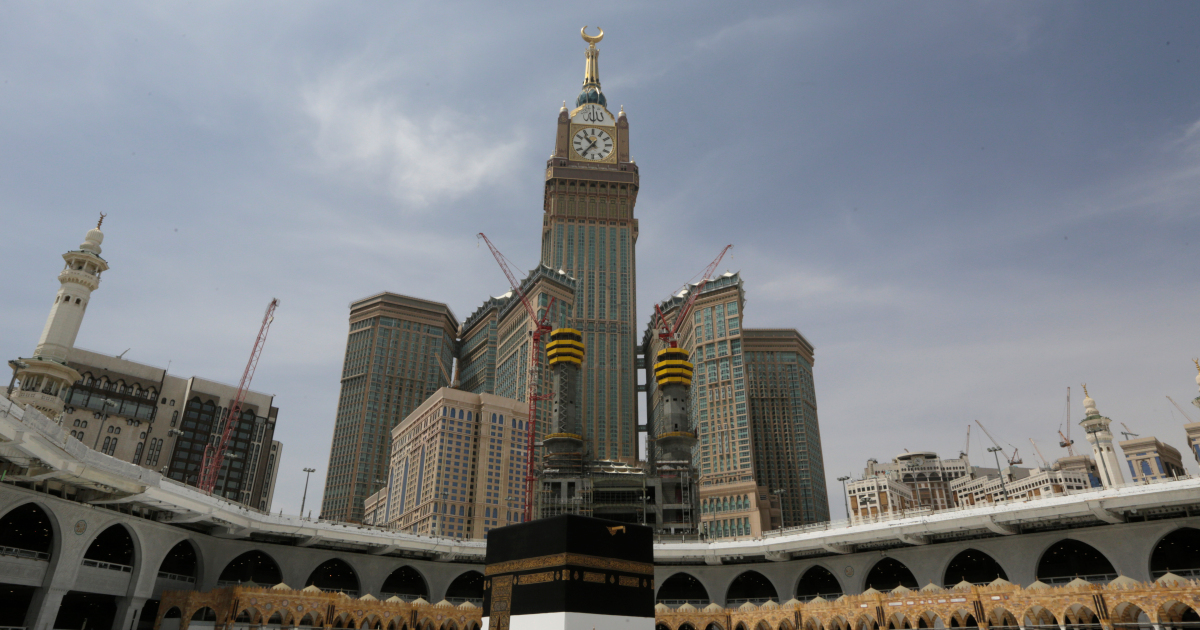
Only 60,000 fully vaccinated citizens and residents of the kingdom are allowed to take part due to coronavirus pandemic.
Hajj pilgrims streamed out of the holy city of Mecca and into the Mina valley on Sunday, launching the rituals of the great pilgrimage which Saudi Arabia is holding in a scaled-down form for a second year.
Only 60,000 fully vaccinated citizens and residents of the kingdom are allowed to take part, far from the vast crowds that descend on Mecca in normal times when the ritual drew up to 2.5 million pilgrims.
Since Saturday, groups of pilgrims have been performing the “tawaf” at Mecca’s Grand Mosque, circling the Kaaba, a large cubic structure draped in golden-embroidered black cloth towards which Muslims around the world pray.
After that, they have been making their way to Mina, where they will spend the night. Mina sits in a narrow valley surrounded by rocky mountains, some five kilometres (three miles) from the Grand Mosque, and is transformed each year into a vast encampment for pilgrims.
Pilgrims were brought there Sunday on buses which were only half-filled to respect social distancing rules, and authorities provided 3,000 electric cars to transport the elderly and those with limited mobility.
“We have applied social distancing inside the camps where there are four pilgrims in each room. We have put barriers between each bed to apply social distancing,” tour operator Hadi Fouad told AFP.
“For the common areas at the camp, like the prayer area and the cafeteria, we have assigned a security company whose guards are spread throughout the camp to make sure there is no crowding.”
Golden ticket
In the high point of the Hajj, worshippers will on Monday climb Mount Arafat.
Also known as the “Mount of Mercy”, it is the site where it is believed that the Prophet Muhammad delivered his final sermon. Worshippers will undertake hours of prayers and Quranic recitals there.
After descending the following day, they will gather pebbles and perform the symbolic “stoning of the devil”.
Having been unable to perform #Hajj last year, this #Hajj2021 pilgrim gives gratitude to God for allowing him to be one of the limited number of pilgrims performing the annual Islamic pilgrimage this year. #FacesOfHajj #InPeaceAndSecurity pic.twitter.com/rnPnOrIfdg — الحج 1442 (@HajjMedia) July 18, 2021
The Hajj, usually one of the world’s largest annual religious gatherings, is one of the five pillars of Islam and must be undertaken by all Muslims with the means at least once in their lives.
This year’s pilgrimage is larger than the pared-down version staged in 2020 but is drastically smaller than in normal times, creating resentment among Muslims abroad who are barred once again.
Participants were chosen from more than 558,000 applicants through an online vetting system, with the event confined to fully vaccinated adults aged 18-65 with no chronic illnesses.
‘A privilege’
“I thank God that we received approval to come, even though we did not expect it because of the small number of pilgrims,” said Abdulaziz bin Mahmoud, an 18-year-old Saudi.
Saddaf Ghafour, a 40-year-old Pakistani woman travelling with her friend, was among the women making the pilgrimage without a male “guardian”, which was a requirement until recently.
“It is a privilege to perform Hajj among a very limited number of pilgrims,” she said.
Since the start of the pandemic, the kingdom has reported at least 462,000 cases of the virus with 7,500 deaths.
It has administered some 15.4 million doses of coronavirus vaccines, according to the World Health Organization. The kingdom is home to over 30 million people.
The Hajj, which typically packs large crowds into congested religious sites, is potentially a super-spreader event for the virus.
But the Hajj ministry has said it is working on the “highest levels of health precautions” in light of the pandemic and the emergence of new variants.
Groups of Pilgrims have arrived in Mina on the Day of Tarwiyah, the eighth day of the Islamic month of Dhu Al-Hijjah and the beginning of their Hajj journey. Upon arrival at Mount Arafat next, the pilgrims will stand united but apart, in reflection and prayer. #Hajj 2021 pic.twitter.com/dXYIwtf1Vx — 𝗛𝗮𝗿𝗮𝗺𝗮𝗶𝗻 (@HaramainInfo) July 18, 2021
Pilgrims are being divided into groups of just 20 “to restrict any exposure to only those 20, limiting the spread of infection”, ministry undersecretary Mohammad al-Bijawi said.
Aside from strict social distancing measures, authorities have introduced a “smart Hajj card” to allow contact-free access to camps, hotels and the buses to ferry pilgrims around religious sites.
The Hajj went ahead last year on the smallest scale in modern history.
Authorities initially said that only 1,000 pilgrims would be allowed, although local media said up to 10,000 eventually took part.
“Public health teams are monitoring the health status of pilgrims around the clock upon their arrival in Mecca,” said Sari Asiri, director of the Hajj and Umrah department at the health ministry, of this year’s precautions.
Anyone found to be infected would be taken to isolation facilities, he added.








